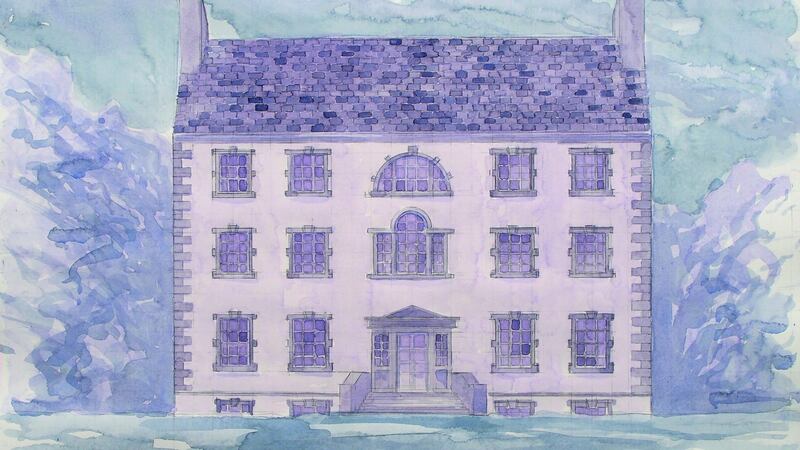An exhibition opening this week in Dublin’s City Assembly House - headquarters of the Irish Georgian Society - provides an impressive visual record of projects supported by the society over the past 20 years.
“Saving Graces: Conserving Ireland’s Historic Architecture” comprises a series of drawings and watercolours by art historian and former Crawford Gallery directorPeter Murray.
While much of the exhibition features historic houses, there are also other interesting structures, from the monumental O’Brien Column at Liscannor to classic gates at Mote Park in Roscommon and a remarkable stone folly built in Ballycumber, Co Offaly by a headstrong but treacherous young army officer.

Given the death of IGS founder Desmond Guinness of Leixlip Castle earlier this month, this is a timely reminder of his efforts to promote public awareness and appreciation of Ireland’s architectural heritage as one who “virtually created architectural conservation in this country”, according to his obituary in this paper. One of the projects illustrated is the mid-18th-century stone boathouse at the castle restored by his widow Penny with support from the IGS’s US membership and dedicated to him.
In the historic battle for the threatened 18th century houses on Hume Street in 1970, it was Guinness’s steely determination and support from others that saved them from destruction. IGS went on to rescue Castletown House in Kildare, Riverstown House and Doneraile Court in Cork, Tailors’ Hall in Dublin and others over the years.
Visual record
IGS executive director Donough Cahill explains that the City Assembly House was the first purpose-built public art gallery in Ireland or Britain when constructed in the late 1700s at 58 Sth William Street, Dublin.
“It was restored with $1.5 million funding raised in the US and completed in 2018,” he says. “Since 2000 the Society has awarded more than €1.6 million raised through funding in grants for 150 projects. We wanted to illustrate what the society, its volunteers and donors, staff and members had achieved over two decades and a comprehensive visual record. All the watercolours are for sale and proceeds will help our work.”
The accompanying 56-page catalogue (€10 from igs.ie) compiled by Peter Murray has fascinating descriptions of the buildings in each painting and the stories behind them.
“Georgian architecture - and its friend and adversary Gothic Revival - in Ireland achieved a level of excellence that is far from provincial. The introduction of the Neo-Classical style in both Britain and Ireland is credited to Richard Boyle, the great grandson of the Earl of Cork who studied with Palladio in Italy,” writes Murray in his introduction. “Even communities that celebrated the burning of great houses during the War of Independence are nowadays conscious of something missing when they see others… being used for festivals and fairs, readings and rallies, concerts and convivial gatherings.”

Notable buildings in the exhibition in receipt of IGS grants include Scregg House in Roscommon, built by the Kelly family in 1767, “a rural palazzo” according to Murray; Ledwithstown House in Longford, attributed to Richard Cassels and now owned by the Feeney family, who have been restoring it for the past 40 years; and a temple at Beaulieu House in Co Louth built in the years after the Battle of Boyne, where the lovely walled garden is often used for events and whose present owner Cara Konig is a direct descendant of the original owners.
Most of the grants are small – between €5,000 and €10,000 – but are enough to get projects over the line.
Conservation
Cahill, an archaeologist and specialist in heritage maintenance and building conservation, agrees that attitudes have changed “hugely over time from what was seen as a modern world from the 1950s and onwards and a rejection of the architecture of the past with no money for conservation, so old buildings were swept away. The overall change in the mindset started with the introduction of the listing of buildings in the mid 1960s.”
He argues that the main challenge now is about implementing legislation from 2000.
When asked for his opinion about the current rash of demolition of so many mid-century modern buildings in Dublin (not within the society’s remit obviously), Cahill observes simply that “there’s a very pro-development attitude in An Bord Pleanála on many issues”.

“My passion is enthusing and exciting people about our built heritage – I am almost evangelical about it,” he says, crediting many local authorities like those in Kilkenny, Meath, Fingal and Dublin City Council for taking on properties and “blazing a trail” of opening country house gardens around the city and country like Marlay Park, Newbridge, Belvedere and Rathfarnham Castle.
The Irish Georgian Society now has an international membership of over 2,400 with chapters in Ireland and the UK, as well as Chicago, New York and Palm Beach. It continues to champion good conservation practice, raises funds through various events and campaigns on architectural heritage planning matters.
Next May the IGS will launch a major exhibition of Irish country house gardens accompanied by a documentary and book. In the meantime, Saving Graces runs in the Daniel O Connell Room (where the elaborate black and white chimney breast in Mitchelstown limestone was rescued from the demolition of writer Elizabeth Bowen’s Irish home Bowen’s Court in Co Cork in 1959). The exhibition will run until the end of October from Monday to Friday with no more than 12 people allowed per slot.











